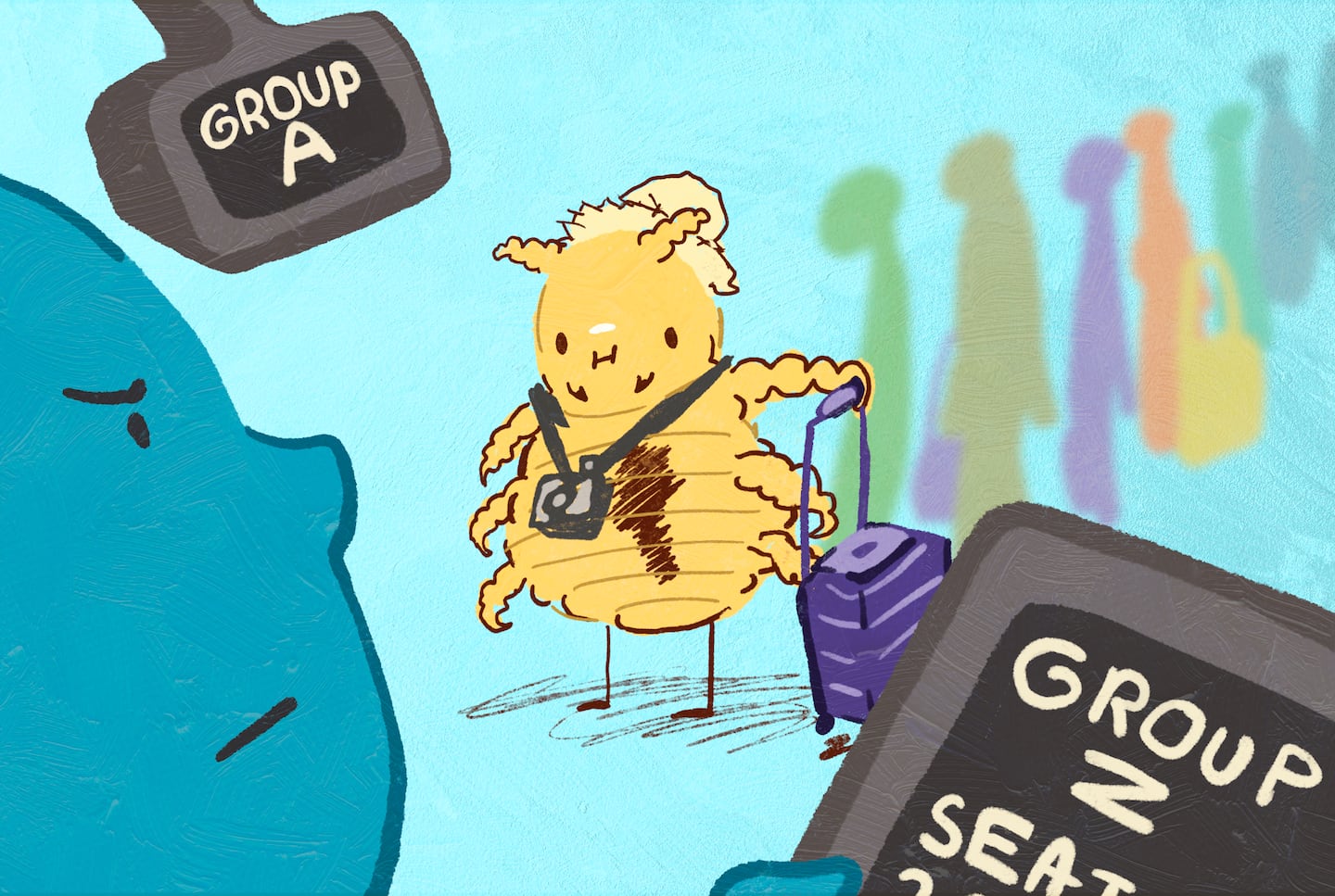Will a chastizing beep or judgmental buzzer change two decades of parasitic herd mentality? There’s always hope. But I have more pressing questions for American Airlines: Why didn’t you start shaming these offenders years ago? Why are you only testing the technology at three airports? Will it include flashing emergency lights? Can you please build an airport jail to punish the queue-cutters?
American has been garnering a lot of press and praise for testing its anti-gate lice technology, but what hasn’t been mentioned is that the airline is also to blame for starting the phenomenon. Nor has anyone pointed out that American’s plan doesn’t address the root causes of gate lice.
In 2008, American was the first major US airline to charge for checked luggage. It started at $15 a bag, with an additional charge for bags over 50 pounds. Other airlines quickly followed. Looking back, $15 for a checked bag is a bargain. American now charges $35 a bag if you pre-book online and $40 at the airport. JetBlue charges upward of $50 a bag, depending on when you fly and how much in advance you book.
According to a report released this week by CarTrawler and Idea Works Company, checked bag fees and other non-ticketed charges, such as seat selection, food, and priority boarding, will net airlines $148.4 billion worldwide in 2024. American’s novel fee created an enormous source of income for airlines.
Cue the ominous music and enter the lice.
When checked bag fees arrived at the airport, so did the gate lice. Some lice crowd the gate because they’re itching to be the first to board, but the other 99 percent of gate-crowders and queue-cutters are trying to avoid checked baggage fees. They want to get on the plane before the overhead bins are full and the dreaded “We need people to gate-check their carry-ons” announcements begin.

It snowballs quickly. Once a few lice start gathering, others can smell the anxiety and join them, and soon, you have a full infestation. American Airlines created the problem, and now they think they can solve it. But there are several flaws with an idea as simple as an audible signal to deter people from cutting the line. If someone is brazen enough to cut, a warning sound won’t stop them. These scofflaws feel that basic social rules don’t apply to them. They need a punishment to fit the crime. Make them board after everyone else is on the plane. Seat them by the lavatories. Begin construction of an airport jail to hold line-cutters, people who talk on their speaker phones, and passengers who don’t use headphones to watch videos.
Several domestic and international airlines have used American’s “new technology” (quotes added to indicate sarcasm) for years. Gate agents scan the pass, look to see if the passenger is trying to board early, and then tell them to move aside if they’re jumping the line. The process hasn’t stopped bad apples from trying to cut ahead and shoehorn their carry-ons (probably larger than they should be) in the overhead at any possible cost.
Perhaps the biggest flaw in American’s plan is that it only targets line-cutters. Most gate lice are not line-cutters. They’re simply honest people trying to save cash by crowding the gate like a flock of distressed sheep wearing neck pillows. Passengers and their carry-ons will continue to clog the boarding area and slow down the process. If I had a nickel for every time I asked a louse if they were in line (the answer is always “no”) because they were blocking access when my group was called, I’d have enough pocket change to buy a bottle of duty-free perfume and perhaps an over-priced Diet Coke from Hudson News.
Thankfully, I have suggestions for American Airlines on how to solve the gate lice situation once and for all.
The most logical solution would be to eliminate checked bag fees. Since I know the likelihood of that happening is the same as “The Garfield Movie” winning an Oscar for best picture, I’ll throw out a few others.
I’ve repeatedly suggested that airlines should make checked bags free and charge for carry-ons. That way, there would be fewer carry-ons slowing down boarding and fewer lice at the gate. The anxiety around boarding would be eliminated because overhead bin space would be plentiful.
So far, no airline has contacted me to elaborate.
Changing the way people get on a plane would also be helpful. First, allow people who do not have carry-on luggage to board. Then, commence general boarding from the back of the aircraft to the front. Or, begin boarding with passengers with window seats, then people with middle seats, and those with aisle seats. It’s common sense.
Or — I have ideas to spare — start a system where passengers must attach a color-coded tag to their carry-on corresponding to their boarding group. Gate agents will scan the carry-on along with the boarding pass. Inside the plane, overhead bins would be reserved by tag color. That way, line cutters would have no advantage.
Finally, airports and airlines must ensure that all passengers can clearly hear boarding announcements or that enough visual indicators tell people when to board. Some lice crowd the gate because they can’t hear the announced zones and don’t want to miss their group.
Until any of these things happen, the gate lice will continue their current behavior. A buzz or bleep isn’t enough. Airlines, please feel free to use any of my ideas at no charge. My reward will come later when I no longer need to weave through lice to get on a plane.
Christopher Muther can be reached at christopher.muther@globe.com. Follow him @Chris_Muther and Instagram @chris_muther.

